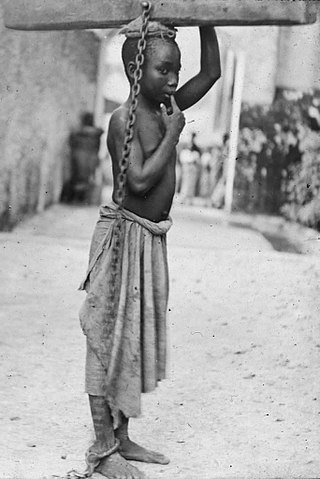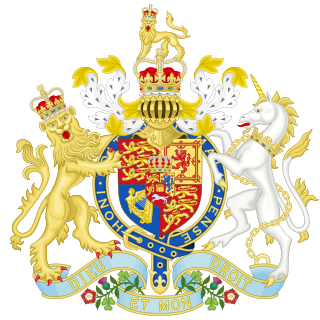
Abolitionism, or the abolitionist movement, is the movement to end slavery and liberate enslaved individuals around the world.

The Atlantic slave trade or transatlantic slave trade involved the transportation by slave traders of enslaved African people to the Americas. European slave ships regularly used the triangular trade route and its Middle Passage. Europeans established a coastal slave trade in the 15th century and trade to the Americas began in the 16th century, lasting through the 19th century. The vast majority of those who were transported in the transatlantic slave trade were from Central Africa and West Africa and had been sold by West African slave traders to European slave traders, while others had been captured directly by the slave traders in coastal raids. European slave traders gathered and imprisoned the enslaved at forts on the African coast and then brought them to the Americas. Some Portuguese and Europeans participated in slave raids. As the National Museums Liverpool explains: "European traders captured some Africans in raids along the coast, but bought most of them from local African or African-European dealers." Many European slave traders generally did not participate in slave raids because life expectancy for Europeans in sub-Saharan Africa was less than one year during the period of the slave trade because of malaria that was endemic in the African continent. An article from PBS explains: "Malaria, dysentery, yellow fever, and other diseases reduced the few Europeans living and trading along the West African coast to a chronic state of ill health and earned Africa the name 'white man's grave.' In this environment, European merchants were rarely in a position to call the shots." The earliest known use of the phrase began in the 1830s, and the earliest written evidence was found in an 1836 published book by F. H. Rankin. Portuguese coastal raiders found that slave raiding was too costly and often ineffective and opted for established commercial relations.

Emancipation Day is observed in many former European colonies in the Caribbean and areas of the United States on various dates to commemorate the emancipation of slaves of African descent.
A Holocaust memorial day or Holocaust remembrance day is an annual observance to commemorate the victims of the Holocaust, the genocide of six million Jews and of millions of other Holocaust victims by Nazi Germany and its collaborators. Many countries, primarily in Europe, have designated national dates of commemoration. In 2005, the United Nations instituted an international observance, International Holocaust Remembrance Day.

The Slavery Abolition Act 1833 was an Act of the Parliament of the United Kingdom which provided for the gradual abolition of slavery in most parts of the British Empire. Passed by Earl Grey's reforming administration, it expanded the jurisdiction of the Slave Trade Act 1807 and made the purchase or ownership of slaves illegal within the British Empire, with the exception of "the Territories in the Possession of the East India Company", Ceylon, and Saint Helena. The Act came into force on 1 August 1834, and was repealed in 1998 as a part of wider rationalisation of English statute law; however, later anti-slavery legislation remains in force.
Sylviane Anna Diouf is a historian and curator of the African diaspora. She is a visiting scholar at the Center for the Study of Slavery and Justice at Brown University and a member of the Scientific Committee of the International Coalition of Sites of Conscience. Her contribution as a social historian, she stressed, "May be the uncovering of essential stories and topics that were overlooked or negated, but which actually offer new insights into the experience of the African Diaspora. A scholar said my work re-shapes and re-directs our understanding of this history; it shifts our attention, corrects the historical record, and reveals hidden and forgotten voices."

The International Slavery Museum is a museum located in Liverpool, UK, that focuses on the history and legacy of the transatlantic slave trade. The museum, which forms part of the Merseyside Maritime Museum, consists of three main galleries which focus on the lives of people in West Africa, their eventual enslavement, and their continued fight for freedom. Additionally the museum discusses slavery in the modern day as well as topics on racism and discrimination.

The United Nations Slavery Memorial, officially known as The Ark of Return – The Permanent Memorial at the United Nations in Honour of the Victims of Slavery and the Transatlantic Slave Trade, is an installation at the Visitors' Plaza of the Headquarters of the United Nations in New York City, intended as a permanent reminder of the long-lasting effects of slavery and the Transatlantic slave trade. It was designed by Rodney Leon, a Haitian-American architect, and installed in 2015.

The Slave Route Project is a UNESCO initiative officially launched in 1994 in Ouidah, Benin. In studying the causes, the modalities and the consequences of slavery and the slave trade, the project seeks to enhance the understanding of diverse histories and heritages stemming from this global tragedy.

Reparations for slavery refers to providing benefits to victims of slavery and/or their descendants. There are concepts for reparations in legal philosophy and reparations in transitional justice. Reparations can take many forms, including practical and financial assistance to the descendants of enslaved people, acknowledgements or apologies to peoples or nations negatively affected by slavery, or honouring the memories of people who were enslaved by naming things after them. Victims of slavery can refer past slavery or ongoing slavery in the 21st century.
The United Nations General Assembly declared the year 2011 as International Year for People of African Descent. That year also marked the 10th anniversary of the World Conference Against Racism, which approved a resolution stating that slavery along with the colonization that sustained it were crimes against humanity.
International Day of Remembrance of the Victims of Slavery and the Transatlantic Slave Trade is a United Nations international observance designated in 2007 to be marked on 25 March every year.
The International Decade for People of African Descent, 2015–2024, was proclaimed by the UN General Assembly in a Resolution (68/237) adopted on 23 December 2013. The theme of the International Decade is "People of African descent: recognition, justice and development".
Badagry Festival is an annual event held in Badagry, a town in Lagos State, Nigeria. It is organised by the African Renaissance Foundation (AREFO). The event reflects the significance of the ancient town during the slave trade era. It is a convergence of culture and display of African heritage. The organizer brings the indegine and culture-loving fans from around the world to celebrate the festival. One of the major highlights is the artistic display by masquerades, dancers, and fire eaters. It features football competition, the beating of Sato drum, and Liberation Day Celebration.
In May 2016, President Francois Hollande announced the formation of a foundation to erect a national slavery and Atlantic slave trade memorial and museum in Paris, France. Identifying the memorial and museum's purpose, Hollande said, “I wish to give to France an institution it still lacks, a foundation for the memory of the slave trade, slavery and its abolition”.

Rodney Leon is an American architect. He is the founder of Rodney Leon Architect. He is the designer of the monument The Ark of Return, and the memorial for the New York City African Burial Ground National Monument. He specializes in urban planning projects in the United States of America, and abroad, projects with cultural, residential, and religious. He is a member of The Haitian Roundtable (HRT). It is an organization of the Haitian-American professionals committed to civic engagement as well as philanthropic endeavors to benefit Haiti. It was started in 2008.

Dorothy Kuya was a leading British communist and human rights activist from Liverpool, the co-founder of Teachers Against Racism, and the general secretary of the National Assembly of Women (NAW). She was a life-long member of the Communist Party of Great Britain (CPGB), and was most famous for being Liverpool's first community relations officer, and for leading a successful campaign to establish Liverpool's International Slavery Museum. During the mid-1980s, Kuya served as the chair of the London housing association Ujima, and built the organisation into the largest black-led social enterprise in Europe.

Liverpool, a port city in north-west England, was involved in the transatlantic slave trade. The trade developed in the eighteenth century, as Liverpool slave traders were able to supply fabric from Manchester to the Caribbean islands at very competitive prices.
The Wake is a planned sculpture by Khaleb Brooks that will be a memorial to the victims of the Atlantic slave trade. It will be sited on West India Quay in East London and is intended to be completed in 2026.











